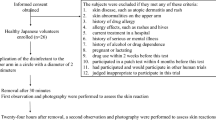Abstract
Thirteen antiseptic aqueous solutions intended for the disinfection of living tissues were compared in regard to their microbicidal effectiveness towardsStaphylococcus aureus andPseudomonas aeruginosa. Six antiseptics, which contain boric acid, eosine, hydrogen peroxide or an organic mercury compound as the active substance, did not fulfil the requirements of the preliminaryin vitro test. The seven other preparations were examined in a practical test, in which bactericidal activity was assessed on artificially contaminated intact skin after exposures of 15 s and 60 s. The most active solution appeared to be 0.5% tosylchloramide sodium, followed by 0.05% chlorhexidine with 0.5% cetrimide. The other preparations, namely 0.05% chlorhexidine without cetrimide, 0.245% chloroxylenol, 0.04% clorofene, 10% povidone-iodine and 0.2% tosylchloramide sodium, were less active in this practical test.
Similar content being viewed by others
References
Reybrouck G. The evaluation of the antimicrobial activity of disinfectants. In: Russel AD, Ayliffe GAJ, Hugo WB, eds. Principles and practice of disinfection, preservation and sterilization. Oxford: Blackwell Scientific Publications, 1981:134–57.
Charrel J, Gevaudan M-J, Mallet M-N, Blancard A, Gevaudan P. Evaluation du pouvoir bactéricide de huit antiseptiques destinés au lavage de type chirurgical des mains. Rev Epidém Santé Publ 1977;25:297–313.
Wewalka G, Rotter M, Koller W, Stanek G. Wirkungsvergleich von 14 Verfahren zur Hygienischen Händedesinfektion. Zbl Bakt Hyg, I Abt Orig B 1977;165: 242–9.
Crémieux A, Guiraud-Dauriac H, Cazac JL, Plumelle Y, Dumenil G. Etude comparative de l'activité antimicrobienne de plusieurs antiseptiques en deux sites cutanés. Rev Instit Pasteur Lyon 1978;11:523–33.
Davies J, Babb JR, Ayliffe GAJ, Wilkins MD. Disinfection of the skin of the abdomen. Br J Surg 1978;65:855–8.
Ayliffe GAJ. The effect of antibacterial agents on the flora of the skin. J Hosp Infect 1980;1:111–24.
Ritter MA, French MLV, Eitzen HE, Gioe TJ. The antimicrobial effectiveness of operative-site preparative agents. J Bone Joint Surg 1980;62-A:826–8.
Beignot-Devalmont M, Sébastien F, Bernard J, Desvignes A. Etude comparative de l'activité antimicrobiennein vitro etin vivo de sept solutions destinées à l'antisepsie de la peau. Ann Pharm Fr 1981;39:147–53.
Kaul AF, Jewett JF. Agents and techniques for disinfection of the skin. Surg Gynecol Obstet 1981;152:677–85.
Reybrouck G, Werner H-P. Ausarbeitung eines neuen quantitativen in-vitro Tests für die bakteriologische Prüfung chemischer Desinfektionsmittel. Zbl Bakt Hyg, I Abt Orig B 1977;165:126–37.
Reybrouck G. Efficacy of inactivators against 14 disinfectant substances. Zbl Bakt Hyg, I Abt Orig B 1979;168:480–92.
Skornik WA, Dressler DP. Topical antisepsis studies in the burned rat. Arch Surg 1971;103:469–74.
Stieritz DD, Bondi A, McDermott D, Michaels EB. A burned mouse model to evaluate anti-pseudomonas activity of topical agents. J Antimicrob Chemother 1982;9:133–40.
Dhingra U, Schauerhamer RR, Wangensteen OH. Peripheral dissemination of bacteria in contaminated wounds; role of devitalized tissue: evaluation of therapeutic measures. Surgery 1976;80:535–43.
Byatt ME, Henderson A. Preoperative sterilization of the perineum: a comparison of six antiseptics. J Clin Pathol 1973;26:921–4.
Marples RR, Kligman AM. Methods for evaluating topical antibacterial agents on human skin. Antimicrob Agents Chemother 1974;5:323–9.
Leyden JJ, Stewart R, Kligman AM. Updatedin vivo methods for evaluating topical antimicrobial agents on human skin. J Invest Dermatol 1979;72:165–70.
Reybrouck G. Antiseptic drugs and disinfectants. In: Dukes MNG, ed. Side Effects of Drugs Annual 5. Amsterdam: Excerpta Medica, 1981:254–9.
Reybrouck G. Antiseptic drugs and disinfectants. In: Dukes MNG, ed. Side Effects of Drugs Annual 8. Amsterdam: Elsevier Science Publishers, 1984:243–7.
Baldry MGC. The bactericidal, fungicidal and sporicidal properties of hydrogen peroxide and peracetic acid. J Appl Bacteriol 1983;54:417–23.
Rutala WA, Cole EC. Antiseptics and disinfectants — safe and effective? Infect Contr 1984;5:215–8.
Author information
Authors and Affiliations
Rights and permissions
About this article
Cite this article
Reybrouck, G. The bactericidal activity of aqueous disinfectants applied on living tissues. Pharmaceutisch Weekblad Scientific Edition 7, 100–103 (1985). https://doi.org/10.1007/BF01968710
Received:
Accepted:
Issue Date:
DOI: https://doi.org/10.1007/BF01968710




